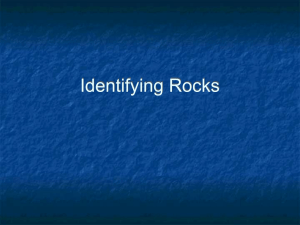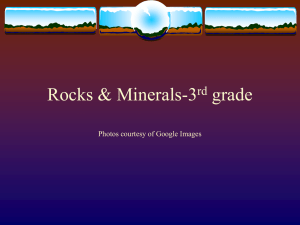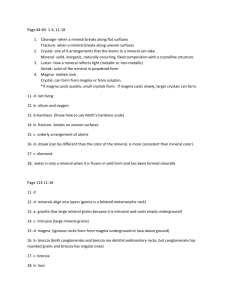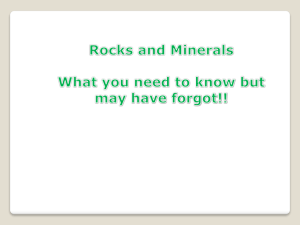minrev
advertisement
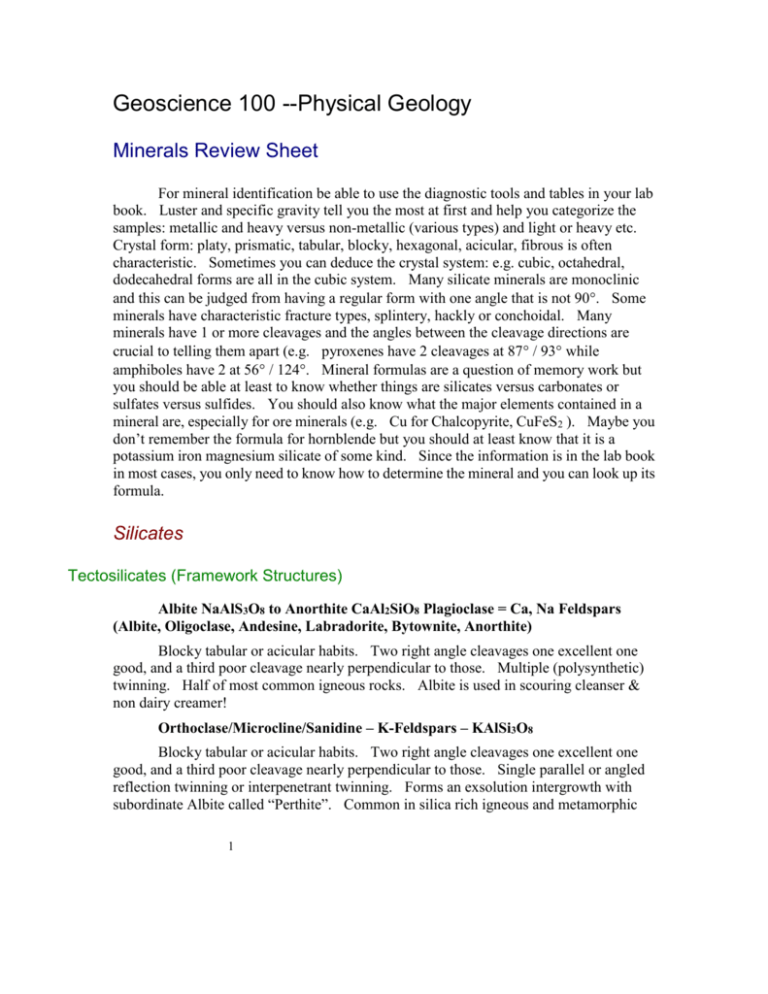
Geoscience 100 --Physical Geology Minerals Review Sheet For mineral identification be able to use the diagnostic tools and tables in your lab book. Luster and specific gravity tell you the most at first and help you categorize the samples: metallic and heavy versus non-metallic (various types) and light or heavy etc. Crystal form: platy, prismatic, tabular, blocky, hexagonal, acicular, fibrous is often characteristic. Sometimes you can deduce the crystal system: e.g. cubic, octahedral, dodecahedral forms are all in the cubic system. Many silicate minerals are monoclinic and this can be judged from having a regular form with one angle that is not 90. Some minerals have characteristic fracture types, splintery, hackly or conchoidal. Many minerals have 1 or more cleavages and the angles between the cleavage directions are crucial to telling them apart (e.g. pyroxenes have 2 cleavages at 87 / 93 while amphiboles have 2 at 56 / 124. Mineral formulas are a question of memory work but you should be able at least to know whether things are silicates versus carbonates or sulfates versus sulfides. You should also know what the major elements contained in a mineral are, especially for ore minerals (e.g. Cu for Chalcopyrite, CuFeS2 ). Maybe you don’t remember the formula for hornblende but you should at least know that it is a potassium iron magnesium silicate of some kind. Since the information is in the lab book in most cases, you only need to know how to determine the mineral and you can look up its formula. Silicates Tectosilicates (Framework Structures) Albite NaAlS3O8 to Anorthite CaAl2SiO8 Plagioclase = Ca, Na Feldspars (Albite, Oligoclase, Andesine, Labradorite, Bytownite, Anorthite) Blocky tabular or acicular habits. Two right angle cleavages one excellent one good, and a third poor cleavage nearly perpendicular to those. Multiple (polysynthetic) twinning. Half of most common igneous rocks. Albite is used in scouring cleanser & non dairy creamer! Orthoclase/Microcline/Sanidine – K-Feldspars – KAlSi3O8 Blocky tabular or acicular habits. Two right angle cleavages one excellent one good, and a third poor cleavage nearly perpendicular to those. Single parallel or angled reflection twinning or interpenetrant twinning. Forms an exsolution intergrowth with subordinate Albite called “Perthite”. Common in silica rich igneous and metamorphic 1 Geoscience 100 --Physical Geology rocks. Quartz SiO2 – Common in igneous, metamorphic, hydrothermal and sedimentary rocks with other silicates. Widespread. Varieties: quartz, aventurine, jasper, citrine, jet, milky, smoky. Used as ore of Si and as an abrasive and an inert mineral filler. Sodalite Na8Al6Si6O24 (Cl 2 , SO4 , S) – Common in Na rich igneous rocks especially in hydrous gneisses and pegmatities (note volatiles in formula). Gem variety is Blue, official gem for the Yukon. Abundant in rocks near Haliburton – Bancroft area Ontario. Zeolites (Chabazite, Heulandite, Natrolite, Stilbite, Thompsonite etc.) – These are soft whitish, pale yellow, pinkish minerals that occur in hydrothermally altered volcanic rocks infilling vugs, veins vesicles and pores, often as radiating and fibrous masses of delicate crystals. Typical in sea floor basalts and intermediate to felsic tuffs especially in hot springs regions like Yellowstone or Wiarakei. Sheet Silicates (Phyllosilicates) Micas Biotite – K(Mg, Fe)(AlSi3O10)(OH)2. Black or brown mica, weathers to gold coloured flakes of phlogopite or vermiculite. Common accessory in most igneous and low grade metasedimentary rocks. Industrially used as a filler and electrical insulator or commutator. Excellent basal cleavage, dark colour and asterism (star shaped figure on thin cleavage sheets) are the most diagnostic properties. Muscovite – KAl2(AlSi3O10)(OH)2. White, colourless, silvery, light green or pale brown mica with nearly hexagonal stacks of monoclinic crystals. Light colour, perfect basal cleavage and low density and hardness are diagnostic. In granites and in sediments as illite (the clay mica) and low grade schistose metamorphic rocks are the most abundant occurrences. Fine grained shear zones in granitic rocks are called sericite. Never found in volcanic rocks. Chromian varieties called fuchsites are pale green and often associated with Archean gold deposits in metamorphic rocks. Common detrital mineral. Used as electrical condensers, capacitors and fillers due to light weight and lo9w thermal and electrical conductivity. Sheet muscovites comes only from pegmatites. Chlorite – (Fe, Mg, Al)6(Al, Si)4O10)(OH)8. Characteristically green from ferric iron though Mn bearing varieties can be brown while Cr bearing varieties can be purple. Green colour, perfect cleavage and non flexible (brittle) cleavage flakes are diagnostic. Common low grade mineral of metamorphic “greenschists” and as hydrothermal veins and amygdules with or without quartz cutting or infilling hydrothermally altered igneous rocks. Common high temperature alteration mineral of biotite and amphibole. Serpentine – Mg6Si4O10(OH)8. Two common forms occur: the fibrous 2 Geoscience 100 --Physical Geology (orthorhombic) chrysotile noted for causing some lung cancers and the platy (monoclinic) antigorite. The serpentine asbestos is mostly chrysotile. Characteristically waxy or greasy appearing and silky in fibrous asbestos form. Both pale green to white occurring in veins and massive replacements of olivine in ultramafic rocks. These are the magnesian equivalent of the more common kaolinite type clay minerals. Commonly used as firewalls and industrial fillers especially in furnaces. Talc – Mg3Si4O10(OH)2. Usually massive for slightly foliated, soapy feel, usually light coloured white grey or green. Called soapstone or steatite as the massive rock form. Associated with low temperature hydrated ultramafic igneous rocks. Perfect basal cleavage with pearly luster. Only weak van der walls forces hold this mineral together and it cleaves the most easily of all. Talcum powder and many industrial uses including refractories and fillers in acid proof bench tops and sinks. Clay minerals Kaolinite – Al6Si4O10(OH)8. – Two common polymorphs kaolinite and halloysite. Earthy, white, absorbent of water, soft and low density. Usually massive. Weathering residue of feldspars from igneous and metamorphic rocks. Common soil mineral. Aluminous form of Serpentine. Commonly used for china clay and other ceramics and refractories. Illite – See muscovite for formula. The clay mica. Common marine clay mineral and most abundant clay mineral of shales. Mined and used to make cinder block. Montmorillonite – Al2Si4O10(OH)2. Frequent substitution of Mg, Fe and small amounts of sodium and calcium makes this a complex mineral and rarely pure. This is the swelling clay. Very expansile and often used as a filler or emulsifier in fluids from drinks, to medicines to drilling muds. Earthy massive appearance, sticks to your tongue and is extremely hygroscopic (sucks up water). Commonly derived from the weathering of volcanic rocks. Glauconite – Complex micaceous mineral found in greensands in marine environments with low deposition rates. Often as discreet grains, pellets or oölites (layered spheres). A sure indicator of marine deposition. 3 Geoscience 100 --Physical Geology Chain Silicates (Inosilicates) Pyroxenes: Augite – Ca(Mg, Fe)Si2O6. Common monoclinic pyroxene of igneous rocks dark green to black prisms with 8 sided cross sections, 90 cleavage, sector zoning and simple twins. Often with rims of hornblende or biotite. Weathers to chlorite. Diopside – Monoclinic. The nearly pure Mg end member of Augite found in magnesian igneous rocks and high grade metamorphic rocks derived from dolomitic limestones. Can be any colour from green to white. Enstatite – MgSiO3. Common orthorhombic pyroxene in gabbros, peridotites of the upper mantle and meteorites also high grade metamorphic rocks like impure marbles and charnokite gneisses. Often a bronze brown colour with a little Fe substitution though the colour can vary from white to pale green to brown. Hard to tell from augite. Rhodonite – MnSiO3. Hydrothermal or metamorphic pink manganese silicate mineral. Hardness and pink colour are diagnostic. This is a semiprecious gem. Amphiboles Hornblende – NaCa2(Mg, Fe, Al,)5(Si, Al)8O22(OH)2. Typical of igneous and metamorphic rocks. Dark green, brown colours and prismatic crystals with 56 / 124 cleavage and 6 sided cross sections with simple twins. Often reacted to or coated by biotite or chlorite. Actinolite – Ca2(Mg, Fe)5Si,8O22(OH)2. Long prismatic crystals or radial or fibrous aggregates occasionally asbestiform. When fine grained and dense this is the nephrite form of jade used in antiquity for hard stone tools and jewelry. Any colour from white to pink to green to violet. Typically found in low and medium grade metamorphosed limestones. 4 Geoscience 100 --Physical Geology Ortho Silicates (Neosilicates) Olivine – (Mg, Fe)2SiO4. Pale yellowish green peridote (gem variety) to reddish in oxidized varieties. The most common mineral in the upper mantle and early high temperature phenocrysts in mafic volcanic rocks and gabbros. Weathers easily at the surface of the earth and despite its hardness and high specific gravity is rarely found in sediments and never in sedimentary rocks. Colour, hardness, high SG and no cleavage are diagnostic as well as association. Zircon – ZrSiO4. Most common ore mineral of zirconium and hafnium, found as a small accessory mineral in most igneous and metamorphic rocks. It is also found in the weathered sediments of these rocks. Tetragonal crystals and cleavage, reddish brown to yellowish colour, high density and hardness are diagnostic. Clear crystals have an adamantine luster almost like diamond and make it a gem variety. The substitution of some uranium and thorium for Zr makes this mineral radioactive and the source of much radioactivity and heat production in crustal rocks from gabbros to granites. Most abundant in sodic granite pegmatites. Mined from beach sands in Queensland. Sphene – CaTiSiO5. Also called titanite. Yellow to brownish wedge shaped monoclinic crystals as a common accessory in igneous and metamorphic rocks. Adamantine luster, heavy at 3.5 and a hardness of 6. Weathers to white leucoxene titanium oxides. Garnet – (Fe, Mg, Mn, Ca)3(Al, Fe)2Si3O12. Typical of moderate to high grade metamorphic rocks and in some igneous rocks especially from the deeper part of the upper mantle. Densities above 3.5 and hardnesses similar to Quartz at 7 plus conchoidal fracture and well formed dodecahedral and trapezohedral crystals are diagnostic. Used as an abrasive. Weathers chemically despite mechanical hardness. Epidote – (Ca)2(Al, Fe)3Si3O12(OH). Pale green pistachio coloured. Often as a hydrothermal vein or vug infilling in altered volcanic rocks. With a hardness of 7 and a SG of 3.5 this is a common heavy sedimentary mineral as well. This makes semiprecious gems called Iona Marble. A closely related mineral, zoisite can be heat treated to produce lavender tanzanite a semi precious gem. Aluminosilicates: - All polymorphs of Al2SiO5 found in metamorphic rocks. Kyanite – Triclinic. Pale blue to grey bladed with different hardnesses of 4 along and 7 across the blades. The old name for this was disthene. This is the medium grade form found in gneisses and pegmatites. It is mined for refractories. Sillimanite – Orthorhombic generally brownish red and fibrous. This is the 5 Geoscience 100 --Physical Geology highest grade form found in gneisses and charnokites (pyroxene gneisses). Rarely in large enough or separable enough crystals to be mined. Characterizes very high temperature metamorphic conditions. Named in honour of Benjamin Silliman and early mineralogist. Andalusite – Coarse prismatic crystals with nearly squarish cross section and a discoloured dot in the center are common for porphyroblasts. Often retrograded to sericite. Typically found in low grade metamorphic shales and slates and occasionally from pegmatites. Mined for the production of refractories. Name derived from Andalusia in Spain. Elemental Minerals: Metals Gold Group: Copper - Cu , Gold – Au , Silver – Ag+ (aq). These metals can occur in quartz veins cutting igneous rocks and as placer deposits in sands and gravel. They may range in size from flakes to nuggets. Heavy, shiny, malleable but different colours and densities, gold the highest at greater than 19 g/cm3. Platinum Group: Platinum – Pt , Palladium – Pd , Iridium – Ir All of these metals occur a nuggets to microscopic flecks as placers derived from ultramafic intrusions and at a few ppm in the intrusions themselves. Usually not visible or a primary ore, only as a secondary metal after Chromium or Nickel mining. Pure Pt is actually denser than gold at 21.5 but usually somewhat lower due to other impurities. Iron Group: Iron – Fe , Nickel-iron (Taenite) – Fe, Ni alloy These minerals are limited to meteorites and a few Precambrian intrusions before Earth had an oxygenated atmosphere e.g., in West Greenland. Also in the mantle as inclusions and the core as a major phase. Cubic forms with octahedral exsolution lamellae that make triangular “widmanstatten” patterns. Mercury – Hg The only metal to occur at STP as a liquid. High density, quicksilver found as a replacive deposit in sandstones in Spain. This one mine sets the world market for Hg. Semi-metals: Arsenic – As. Massive, lumpy or stalactitic crystals in hydrothermal veins with silver and nickel ores. Volatile when heated to give a garlic odour. And white fumes of arsenic oxide. Poisonous as it proxies for Sulfur in protein linkages. Bismuth – Bi. Silvery white with a reddish hue and iridescent tarnish on granular or foliated crystals. Occurs in some veined silver and nickel deposits. Also produced as 6 Geoscience 100 --Physical Geology a byproduct of silver and copper mining. Bismuth compounds are used in some pharmaceuticals and cosmetics but banned in most of the EU for suspected health risks. Non-Metals Carbon Group: Diamond – C. Hardest natural mineral at 10. Body centered cubic lattice and all covalent bonds making octahedral cleavages. Diamonds are cleaved not “cut”. Adamantine luster. Most are not of gem quality and are used as abrasives. Stable and formed only at high pressure deeper than 160 km in the upper mantle. These only occur where younger kimberlite pipes carry up accidental diamond inclusions from the deep continental keels where Precambrian subduction zones took carbon back down into the mantle. Graphite – C. Very soft mineral due to weak Van der Waals bonds between covalent sheets. Used as a dry lubricant and as a strong light weight composite for whisker crystals that are long fibers. Stable in metamorphic and igneous rocks throughout the crust. The common reduced form of carbon. Sulfur – S. Yellow to brown, clear to turbid, soft about 2 and low density about 2. Tabular dipyramidal crystals with conchoidal fracture. Melts at 113C burns with a bright blue flame and makes sulfur dioxide noxious smelling gas. Found near recent volcanic vents and fumaroles. Also in sedimentary deposits like salt domes due to sulfate reducing bacteria. Abundant byproduct from sour gas wells more than meets world needs with stockpiles of unused material. Oxides & Hydroxides Corundum – Al2O3. Hexagonal either tabular or short prisms with a hardness of 9. Sector twinning and colour zonation often with asterism due to aligned inclusions. No cleavage but a basal parting across the prisms. Gem varieties are ruby and sapphire with Fe and Ti impurities for coloration. Very refractory and hard, used as an abrasive. Together with magnetite this makes up emery grinding stone. Common in high grade metamorphic and aluminous igneous rocks like pegmatites. Hematite – Fe2O3. Reddish or metallic grey hexagonal to massive iron oxide. Many different crystal forms from botryoidal to fibrous. This is the most common ore mineral for iron derived from metamorphosed Precambrian marine sediments. Hardness 7 Geoscience 100 --Physical Geology of 6 and a red to red-brown streak are diagnostic. Specular hematite is often called Alaska Black Diamond as a semi precious gem. Magnetite – Fe3O4. Very common accessory mineral in igneous and metamorphic rocks. Strongest natural magnetic mineral called lodestone in antiquity. Cubic form but octahedral crystals with a black streak This is the most common magnetic carrier mineral for magnetic remnance in rocks. Uraninite – UO2. Pitchblende is black and all radioactive. This mineral is heavy at nearly 11 with a black to brown streak and cubic or octahedral crystals. The name comes from the sub-metallic pitch like luster. Occurs in igneous and hydrothermal settings as well as Precambrian quartz pebble conglomerates in the Athabasca Basin and in the Witwatersrand of South Africa before there was free oxygen in the atmosphere. Important ore of Uranium for fission reactors and bombs. Goethite – FeO(OH). Often massive, pisolitic or botryoidal blackish brown to yellowish brown with a brownish yellow streak and a density about 4. Limonite – Fe(OH)3 . Yellow soft massive iron oxide component of “yellow boy” in gossans over sulfide deposits and where Fe is oxidized in spring seeps. Pyrolusite – MnO2 . Bluish to purplish brown or black dendrites and coatings on joint surfaces and desert varnish on the underside of rocks in arid environments. Manganite is the manganese equivalent of goethite and the most common manganese ore mineral. Several different manganese oxyhydroxides occur as nodules on the deep seafloor and may represent a future resource. Manganese is used to toughen steel. Carbonates Calcite – CaCO3. Rhombohedral crystal system. Most abundant and stable form of calcium carbonate and the most widespread carbonate mineral in all environments from the shallow seas to hydrothermal veins, metamorphic rocks and even in the upper mantle. Distinctive rhombohedral cleavage and vigorous reaction to acid are the most diagnostic properties. Soft, low density and twinning striations. Optically clear crystals give pronounced double diffraction. May be any colour though white and colourless are most common. Sometimes in dogtooth shaped crystals. This is the ore mineral of Calcium and is roasted to make lime for cements. Aragonite – CaCO3. Orthorhombic crystal system. Common form of calcium carbonate in shells. Can also occur in stalactites and in hydrothermal veins or hot springs deposits. Dolomite – CaMg(CO3)2 . Rhombohedral, widespread in hydrothermally altered 8 Geoscience 100 --Physical Geology limestones where it is often yellowish brown though any colour is possible. Weak reaction to acid and higher SG than calcite are diagnostic. Siderite – FeCO3 . Yellowish brown slightly opaque and high density with rhombohedral cleavage. Often distorted or curved faces and cleavages. Also occurs in bedded sedimentary deposits and concretions. Sedimentary deposits in western Alberta were used as iron ore. Weathers to iron oxides and hydroxides. Malachite – Cu2(CO3)(OH)2 . Prismatic, acicular or massive botryoidal masses of intense green translucent material. Well formed crystals have 2 distinct types of cleavages. Heavy with a pale green streak and weak reaction to acid. Widespread in the surfacial cover of copper deposits. Azurite – Cu3(CO3)2(OH)2 . Monoclinic to massive, blue to very dark translucent blue moderately soft crystals with a pale blue streak and weak reaction to acid. Occurs with malachite in the surfacial cover of copper deposits. Sulfates Gypsum – Ca(SO4)-2H2O. Simple tabular or prismatic crystals often with one curved or warped side and single swallow tail twins or rosettes. 1 perfect cleavage and 2 poorer cleavages. Pale colours from whites to yellows and pale tan. Low hardness of 2, flexible cleavage fragments and bent crystals are diagnostic. Most common evaporate mineral after halite. Often is sedimentary beds with calcite. Mined for wallboard and plaster and fillers in papers and paints. Anhydrite – Ca(SO4). Massive and rarely well crystallized. This is the high temperature form of calcium sulfate deposited directly from hot or hypersaline sea water or from the dehydration of gypsum. Mainly as sedimentary deposits interbedded with gypsum. Barite – Ba(SO4). Heavy white tabular or prismatic crystals with 3 cleavages at 78, 90 and 101 from one another. Density (4.5) orthorhombic crystal form, and cleavages are diagnostic. Most common ore mineral of Barium occurs in low temperature hydrothermal veins and replacing some limestones. Used to increase the density of drilling muds and in medical x-ray applications. Jarosite – KFe3(SO4)2(OH)6. Amber yellow to dark brown vitreous to resinous crystals as crusts and coatings on oxidized iron sulfide minerals and sulfide ore deposits. Along with limonite this is a component of “yellow boy” in gossans and acid rock drainage settings. This belongs to the trigonal system but crystals appear pseudo-cubic or fibrous. Relatively soft about 3. 9 Geoscience 100 --Physical Geology Sulfides Pyrite – FeS2. Most common sulfide mineral as cubes, pyritohedrons (striated) or octahedrons also massive. Common in all rock types from soft anoxic muds to the mantle. Brassy striated cubes that fracture and a rotten egg gas smell on reaction with acid are distinctive. This mineral is the furthest out of equilibrium at the surface of the earth and oxidizes to rusty yellow orange limonite and acid drainage. The streak is greenish to brownish black and darker than chalcopyrite. Iridescent colours when tarnished. It is the hardest of the yellow brassy metallic minerals at 6.5. There are other iron sulfides including the slightly iron deficient magnetic pyrrhotite of high temperature metamorphic deposits and the concretionary marcasite of sediments. Chalcopyrite – CuFeS2 . Most common ore mineral of copper though several other copper and copper iron sulfides are usually associated in igneous and hydrothermal deposits. More yellowish than pyrite and a distinctively yellow green streak are the best properties. Usually it has an uneven brittle fracture but may exhibit a distinct tetrahedral cleavage, while pyrite never does. The tarnish in shades of golds, blues and purples is characteristic of this and other copper sulfides. Galena – PbS. Most common ore mineral of Lead. Distorted dark silvery grey cubes with whitish oxide coatings. High specific gravity (7.5) and perfect cubic cleavage with octahedral partings and Lead grey streak are diagnostic. Mined for munitions, batteries and paint pigments. Sphalerite – ZnS. Most common ore mineral of Zinc. Makes resinous yellow brown to dark brown tetrahedral or dodecahedral crystals with reddish internal reflections in reflected light. It has 4 perfect cleavages and conchoidal fracture. Often called “blackjack”. Occurs with other sulfide minerals notably Cu and Pb bearing types. Sphalerite is usually hydrothermal in occurrences. There is a high temperature hexagonal polymorph called wurtzite that is found in the black smoker seafloor deposits and in high temperature metamorphic deposits. Arsenopyrite – FeAsS. Orthorhombic system with twin striated rhombic prisms of steel gray to silvery white. Most common arsenic mineral. Poisonous. Smells like garlic on scratching or reacting with acid. Occurs in gold bearing quartz veins and with massive polymetallic sulfides. There is enough waste arsenic from arsenopyrite in the drifts of the Giant Yellowknife mine to poison the entire world. Ore deposits with arsenopyrite or other arsenides are more difficult to extract and to deal with due to toxicity. 10 Geoscience 100 --Physical Geology Phosphates: Apatite – Ca5(PO4)3(OH, F, Cl) Massive clear, green, yellow or brown in pegmatites and hydrothermal veins or tiny acicular hexagonal prisms included inside other minerals. This is the most common phosphate mineral and most important ore of phosphorous It is the mineral component of teeth and bones including fossils thereof. Most commercial deposits are sedimentary accumulations from former marine organisms. To mine it sulfuric acid is used to convert it to soluble phosphates for fertilizers. It is a minor component of all rock types generally <5%: igneous, metamorphic and sedimentary. Because it contains a small amount of uranium and thorium and can be used for radioactive dating. Hardness of 5 with translucent colours and fracture more prevalent than its one poor cleavage are diagnostic. Halides: Halite – NaCl. Common rock salt, cubic, soft, light, soluble. Major ore of sodium. Principally found in evaporate deposits. Cubic cleavage, solubility and low hardness are the giveaway properties. Fluorite – CaF2 . Commonly coloured and with variable colour zonation across individual mineral specimens in shades or purple, blue yellow or clear. Octahedra and octahedral cleavage is the most diagnostic property. Most common fluoride mineral and ore of fluorine. Common in granitic rocks especially pegmatites. Also found in some low grade metamorphic rocks. Sylvite – KCl. Cubic and cubic cleavage. Most common potassium salt mined commercially in Saskatchewan and the most important ore of potassium. Typically reddish orange stained clear crystal and solubility are the most diagnostic properties. Often called potash commercially though technically this applies to the oxide/hydroxide, not the chloride form. 11




